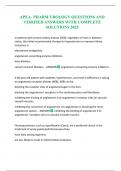Summary
Samenvatting Laeken Declaration on the future of the European Union - Steven Van Hecke
- Module
- Institution
Passed in first sitting! Summary of “Laeken Declaration on the future of the European Union” in the course of European Integration since 1945 by Professor Steven Van Hecke (KUL) The professor wants you to read the “Laeken Declaration” (part of Chapter 5) and be able to apply/explain it...
[Show more]












